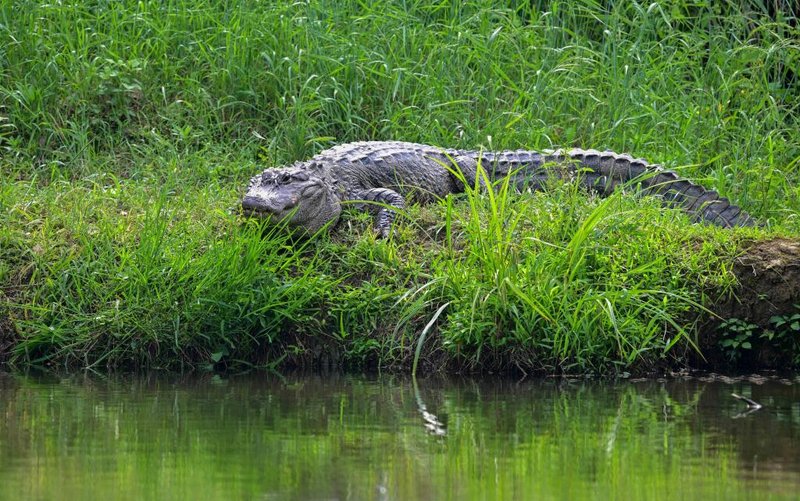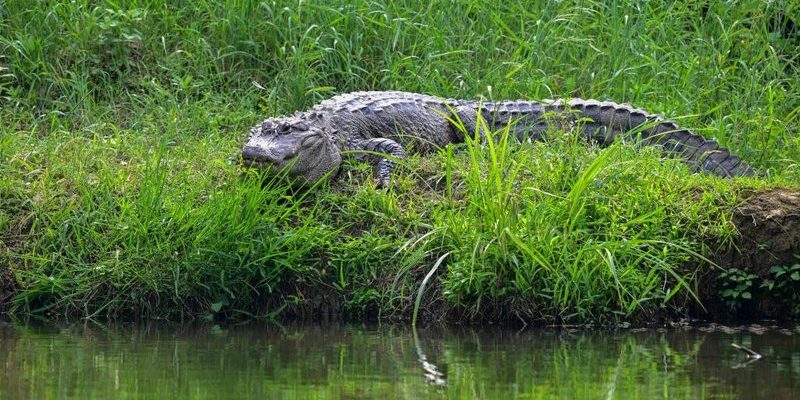
The Chinese alligator (Alligator sinensis) is smaller than its American cousin, measuring about 5 to 7 feet in length. Found mostly in the Yangtze River basin, these alligators face threats from habitat loss and pollution. Yet, their unique adaptations help them navigate these challenges. This article explores the remarkable features that allow the Chinese alligator to not just survive but flourish while reminding us how crucial it is to protect their habitat.
Physical Adaptations: Nature’s Design
One of the most striking things about the Chinese alligator is its physical adaptations. These reptiles have evolved over time to become remarkably efficient at blending into their surroundings. Their dark, murky skin helps them camouflage in the muddy waters of the Yangtze River, making it hard for both predators and prey to spot them. Think of it as nature’s version of wearing the perfect disguise.
Their bodies are also built for survival. With compact limbs and a wide, armored back, they can navigate through dense vegetation and murky waters easily. The powerful tail acts almost like a propeller, enabling swift movements when they need to strike quickly. Honestly, if you were to see one glide through the water, you’d have to remind yourself you’re not watching a scene from a nature documentary.
Moreover, the Chinese alligator has a unique ability to endure colder temperatures compared to other alligator species. This adaptation allows them to remain active during cooler months when food may be harder to find. It’s like having an internal thermostat, which is a pretty handy trait when you’re living in a variable climate.
Diet and Feeding Habits: The Opportunistic Feeder
The Chinese alligator is considered an opportunistic feeder, meaning it takes advantage of whatever food sources are available. This flexibility in diet is crucial for survival, especially in changing environments. They primarily feed on fish, snails, crabs, and small mammals. Picture a buffet—this alligator doesn’t stick to one dish but samples various offerings on the table.
Their jaw structure also plays a vital role in how they catch food. The jaws are designed to snap shut quickly, allowing for quick strikes. They don’t chew their food; instead, they swallow it whole, which is efficient when you’re hunting prey in a murky river. Considering that some prey might be larger than others, this adaptation makes them effective hunters.
You might be wondering how they find food in dark waters. Well, their keen sense of smell and sensitive skin enable them to detect movement and vibrations. This means they can sense when a fish is nearby, even in low visibility. It’s like having a sixth sense that keeps their bellies full.
Behavioral Adaptations: Staying Under the Radar
Behavior is just as important as physical traits when it comes to survival. The Chinese alligator exhibits some interesting behavioral adaptations. For starters, these reptiles are primarily nocturnal, which means they come out to hunt during the night. This behavior reduces the risk of encountering larger predators during the day. Think of it as choosing to shop at night to avoid crowded stores.
Moreover, they have a unique way of regulating their body temperature. They can often be found basking in the sun during cooler mornings to warm up before heading into the water. This basking behavior is crucial for maintaining energy levels, especially since their cold-blooded nature relies on external heat sources to be active. It’s like charging your phone before heading out for the day—smart and essential.
They also tend to be solitary, preferring to hunt and live alone rather than in groups. This reduces competition for food and resources, making it easier for each alligator to carve out its niche in the environment. Their solitary lifestyle simplifies the survival game; less fuss means more focus on what matters—eating and staying safe.
Reproductive Strategies: Ensuring Future Generations
When it comes to reproduction, the Chinese alligator has developed some fascinating strategies to ensure its survival. These alligators have a relatively long breeding season. Mating typically occurs in June, followed by the female laying around 10 to 30 eggs. Here’s the thing: the mother is quite protective of her nest. She often stays nearby, guarding her young and keeping potential threats at bay, which significantly increases their chances of survival.
The nesting behavior is particularly interesting. Females construct their nests using vegetation, which helps maintain a stable temperature for the eggs. After about 60 days, the eggs hatch, and the tiny alligators are already equipped with the instincts to hunt on their own. It’s like sending kids off to summer camp equipped with everything they need to succeed—just without the sunscreen!
Interestingly, the survival of the hatchlings depends on external factors, like temperature. If the eggs are kept in warmer conditions, more female hatchlings will emerge; cooler conditions yield males. This temperature-dependent sex determination ensures a balanced population that can thrive in varying environmental conditions. Nature really does have a plan!
Conservation Efforts: Protecting the Survivors
Despite their awesome adaptations, the Chinese alligator is classified as a critically endangered species. Habitat loss due to urbanization and pollution poses significant threats to their survival. Conservation efforts are crucial. Local organizations and the Chinese government have stepped up to protect habitats and raise awareness about the importance of these alligators.
One method being employed is restoration of wetland areas. By creating and maintaining their natural habitats, these organizations help ensure that alligators have a safe space to live and breed. Think of it like providing a quiet, cozy home for a family; it’s about making the environment suitable for growth and survival.
Public education is another vital part of conservation. By teaching communities about the importance of the Chinese alligator and the ecosystems they inhabit, there’s a chance to inspire future generations to care for these creatures. It’s about creating a ripple effect that can lead to lasting change.
With ongoing efforts, there’s hope yet for the Chinese alligator. By adapting to challenges and having dedicated people fight for their survival, these remarkable creatures can continue to flourish.
Final Thoughts: Embracing Adaptation
Survival isn’t just about strength or speed; it’s often about the ability to adapt. The Chinese alligator teaches us that even in the face of adversity, remarkable traits can lead to continued existence. From their unique physical features to clever reproductive strategies, these alligators show us the beauty of evolution.
As we continue to face environmental changes, the lessons learned from creatures like the Chinese alligator can guide us in conservation efforts. By embracing and understanding adaptation, we can work together to ensure a brighter future for not only this species but many others who share our planet. Protecting them isn’t just about saving alligators; it’s about safeguarding biodiversity for future generations. So, let’s rally together to support these ancient survivors and the unique ecosystems they call home.

